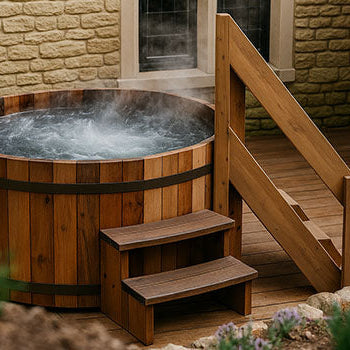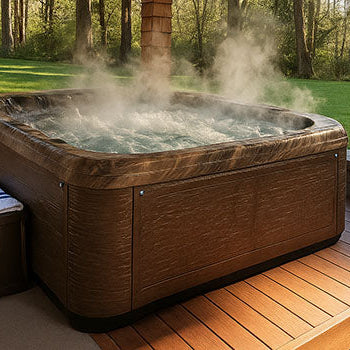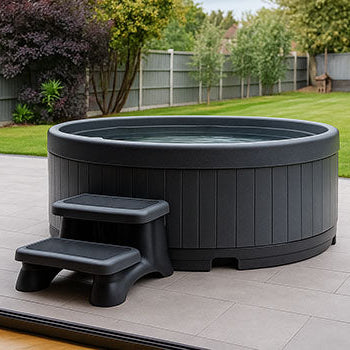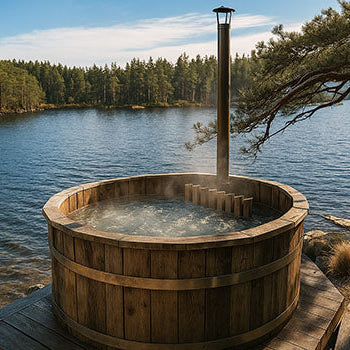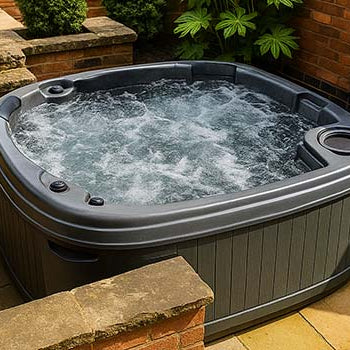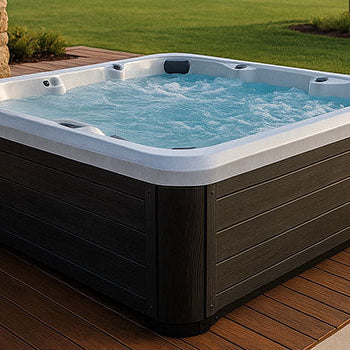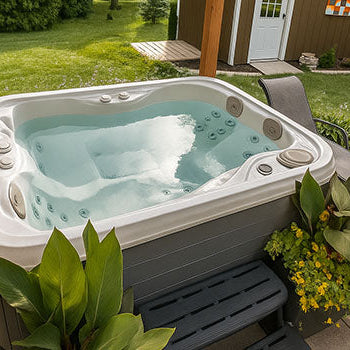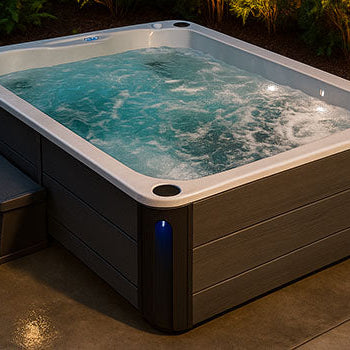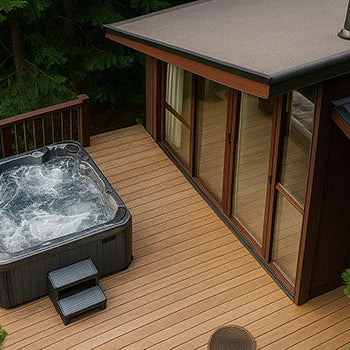Ever climbed into your hot tub expecting pure bliss, only to find it bubbling like a poorly made cappuccino? Hot tubs foam up because of leftover lotions, soaps, detergents, and off-balance water chemistry. And yes, it can happen to any spa, Acrylic Hot Tubs, Rotomoulded Hot Tubs, even charming Wooden Hot Tubs. Stick around and let’s tackle the bubbly beast once and for all.

What Exactly is Hot Tub Foam?
Understanding Surface Tension and Bubbles
To get why your hot tub’s turning into a bubble machine, start with surface tension. Water likes to stay flat and smooth, unless something sneaky breaks that surface. Add in oils or soap, and suddenly, bubbles stick around longer than your nosy neighbour.
Why Heat and Aeration Encourage Foam
When the jets kick in, they churn air into the water, and heat lowers the surface tension even more. That mix is like a perfect storm for foaming. You’ve got a bubble cocktail on tap, and your hot tub didn’t ask for it.
Uncovering the Common Causes of Foaming
Bather Contaminants: Lotions, Oils, Soaps, and Cosmetics
Let’s be honest, most of us jump straight into the tub without rinsing off. But moisturisers, hair gel, sunscreen, and even makeup sneak into the water. Once those mix with warm water and high-pressure jets, your spa turns into a frothy mess.
Laundry Detergent Residue on Swimwear
Even freshly washed swimwear carries a little detergent. And in a small space filled with hot water, that’s all it takes. A single swimsuit can leave enough residue to create foam across the surface.
Low Calcium Hardness: The Role of Soft Water
Water that’s too soft sounds luxurious, until it makes your spa go sudsy. Low calcium levels mean less resistance to foaming agents like soaps and oils. Especially in Acrylic Hot Tubs, soft water can be trouble.
High Total Dissolved Solids (TDS) Build-up
If your water’s been sitting in the tub too long, it’s likely packed with all sorts of invisible stuff: salts, body sweat, skin flakes. That’s TDS. When levels are high, foam becomes much harder to control.
Unbalanced Water Chemistry (pH, Sanitiser Levels)
Off-balance pH or sanitiser levels weaken your spa’s defences. Bacteria thrive. Oils float. And the water starts to rebel, with bubbles. If your water test strips look off, that could be your culprit.
Biofilm Lurking in the Plumbing
Biofilm is like spa plaque, slimy buildup hiding in pipes, feeding on the stuff you can't see. Over time, it breaks loose and taints your water. If your tub smells off and keeps foaming, this could be what’s lurking behind the scenes.
Using Incorrect or Low-Quality Chemicals
Cheaper spa chemicals might save you money short term, but they often leave residues behind. That leftover gunk builds up, and surprise, a foam party. Stick to high-quality, spa-grade products made for your specific hot tub.
Quick Fixes: How to Get Rid of Foam Fast
Using Anti-Foam Chemicals (Defoamers) Effectively
Defoamers are like a magic eraser for bubbles. Just a few drops and the foam disappears. But don’t be fooled, they treat the symptom, not the root problem. Use them sparingly while you work on long-term fixes.
Skimming Foam from the Water Surface
It might feel old-school, but skimming helps. Use a towel or net to scoop the top layer of foam. It won’t solve everything, but it does give your spa a quick refresh while you troubleshoot.
Testing and Re-balancing Water Chemistry
Grab your water test kit and check the basics, pH, alkalinity, and sanitiser. Off readings? Adjust immediately. Getting the balance right is one of the fastest ways to stop foam from coming back.
The Role of Shock Treatment (Oxidising)
When your water smells weird and bubbles won’t quit, it’s time to shock. Spa shocks oxidise all the gunk: body oils, sweat, detergent, and bacteria. It’s a deep clean for your hot tub water.

Preventing Foam: Long-Term Strategies
The Pre-Soak Shower Rule (No Soaps!)
No one likes rules before relaxing, but this one’s worth it. Rinsing off before you soak removes the oils, lotions, and residues that cause foam. Just don’t use body wash or shampoo, water only!
Proper Swimwear Care (Rinsing Thoroughly)
Skip the scented detergent. Instead, rinse your spa swimwear by hand with fresh water. You can even have a “hot tub only” swimsuit to keep things clean and foam-free.
Maintaining Correct Calcium Hardness Levels
Use a calcium increaser to reach that sweet spot; 150 to 250 ppm is your friend. Soft water might feel silky, but it loves to foam. Especially for Acrylic Hot Tubs, this step is key to keeping things smooth.
Regular Draining and Refilling Schedule (Addressing TDS)
Hot tubs need fresh water to thrive. Draining and refilling every 3–4 months keeps Total Dissolved Solids in check. More often, if you’re soaking daily or sharing with friends.
Consistent Filter Cleaning Routine
Think of your filter like your hot tub’s nose, it catches the bad stuff. Clean it weekly and deep-clean monthly. Dirty filters let oils and debris sneak back in, and yes, that means foam.
Using a Pipe Flush Product Before Draining
Before your next water change, run a pipe flush. It pushes out hidden buildup (like biofilm) hiding in the plumbing. Clean pipes mean fresher, clearer, foam-free water.
Choosing Quality Hot Tub Chemicals
Invest in proper spa chemicals made for your tub type. Whether it’s a Wooden Hot Tub for winter nights or a Rotomoulded Hot Tub on the patio, the right products make all the difference.
When Foam is a Symptom of a Deeper Issue
Persistent Foam That Won't Go Away
If foam keeps reappearing despite your best efforts, something’s off. It could be contaminated water, a clogged filter, or an invisible plumbing issue. Time to take a closer look, or call in a spa tech.
Foam Accompanied by Cloudiness or Odours
Foam’s one thing. But when the water turns cloudy and starts to smell funky? That’s a warning sign. It likely means bacteria buildup or worse. Drain, flush, deep clean, and start fresh.

Conclusion: Achieving and Maintaining Clear, Foam-Free Water
Foam in your hot tub might seem harmless at first, but it’s your spa’s way of waving a white flag. The good news? It’s preventable. Whether you’re soaking in a stylish Acrylic Hot Tub or chilling in a classic Wooden Hot Tub, keeping the water clean is what makes the experience magical.
Make the pre-soak rinse a habit. Choose spa-safe chemicals. Stick to your cleaning routine. Once you do, you’ll spend less time scooping bubbles and more time unwinding the way you intended.
Because a hot tub should be your peaceful escape, not a foam fight.
